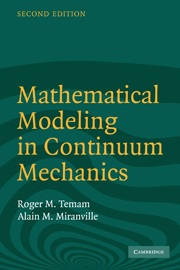Book contents
- Frontmatter
- Contents
- Preface
- A few words about notations
- PART I FUNDAMENTAL CONCEPTS IN CONTINUUM MECHANICS
- 1 Describing the motion of a system: geometry and kinematics
- 2 The fundamental law of dynamics
- 3 The Cauchy stress tensor and the Piola-Kirchhoff tensor. Applications
- 4 Real and virtual powers
- 5 Deformation tensor, deformation rate tensor, constitutive laws
- 6 Energy equations and shock equations
- PART II PHYSICS OF FLUIDS
- PART III SOLID MECHANICS
- PART IV INTRODUCTION TO WAVE PHENOMENA
- Appendix: The partial differential equations of mechanics
- Hints for the exercises
- References
- Index
3 - The Cauchy stress tensor and the Piola-Kirchhoff tensor. Applications
Published online by Cambridge University Press: 06 July 2010
- Frontmatter
- Contents
- Preface
- A few words about notations
- PART I FUNDAMENTAL CONCEPTS IN CONTINUUM MECHANICS
- 1 Describing the motion of a system: geometry and kinematics
- 2 The fundamental law of dynamics
- 3 The Cauchy stress tensor and the Piola-Kirchhoff tensor. Applications
- 4 Real and virtual powers
- 5 Deformation tensor, deformation rate tensor, constitutive laws
- 6 Energy equations and shock equations
- PART II PHYSICS OF FLUIDS
- PART III SOLID MECHANICS
- PART IV INTRODUCTION TO WAVE PHENOMENA
- Appendix: The partial differential equations of mechanics
- Hints for the exercises
- References
- Index
Summary
This chapter is central to continuum mechanics. Our aim is to model and study the cohesion forces (or internal forces) of a system, that is to say the actions exerted by part of a system S on another part of S. Our study leads to the definition of the Cauchy stress tensor and to the equations of statics and dynamics that then follow by application of the fundamental law of dynamics.
The Cauchy stress tensor is expressed in the Eulerian variable; its analogue in the Lagrangian variable is the Piola-Kirchhoff tensor introduced in the last section of this chapter.
Hypotheses on the cohesion forces
We are given a material system S. Let S = S1 ∪ S2 be a partition of S, Ω1 and Ω2 being the domains occupied by S1 and S2 at a given time. In Sections 3.1 and 3.2, the time will be fixed and will not appear explicitly. We assume that the common boundary Σ of Ω1 and Ω2 (see Figure 3.1) is sufficiently regular.
Concerning the actions exerted by S2 on S1, we make the following assumptions introduced by Cauchy:
(H1) The forces exerted by S2on S1are contact forces, which means that they can be represented by a vector measure dφ concentrated on Σ = ∂ω1 ∩ ∂Ω2.
(H2) The measure dφ is absolutely continuous with respect to the surface measure dΣ, that is,
where T is the (vector) surface density of the forces.
(H3) The function T depends only on the point x of Σ and on the unit normal n to Σ at point x:
- Type
- Chapter
- Information
- Mathematical Modeling in Continuum Mechanics , pp. 42 - 56Publisher: Cambridge University PressPrint publication year: 2005

